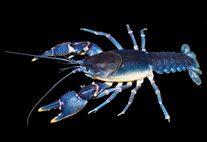Abstract
Cambarus (Jugicambarus) dubius Faxon, 1884 is a polychromatic montane burrowing crayfish with a long, turbulent taxonomic history since its original description by Walter Faxon in 1884. Over the years, many distinct color phases have been identified, with the majority of these being confined to a specific geographic or physiographic region in the central and southern Appalachians. Previous investigations of this species (e.g., Dewees 1972) were unable to discover consistent morphological differences among the various groups, and thus were unable to clarify what has long been considered a species complex. Due to lingering taxonomic issues, we herein re-describe, delimit and restrict the concept of C. dubius. We also describe a new species, Cambarus (Jugicambarus) pauleyi, from the same complex, which can be identified through the use of geographic distribution, coloration, and distinct morphological characters. Cambarus dubius sensu stricto, as defined here, is restricted to the “typical form” which has an overall orang-ish color pattern on the dorsal and lateral sides, with cream ventrally. The distribution of C. dubius s.s. is limited to the central and northern portions of the Allegheny Mountains and high elevations of the Appalachian Plateau in central West Virginia, western Maryland, and southcentral Pennsylvania. In contrast, C. pauleyi is endemic to high elevation wetlands (>700 m) in the Meadow and Greenbrier River basins in Greenbrier and Monroe counties, West Virginia. Cambarus pauleyi can be differentiated from C. dubius s.s. by 1) its blue dorsal coloration compared to the orange coloration of C. dubius s.s., 2) its large (palm depth/(palm length) ratio, and 3) its smaller (rostral width)/(rostral length) ratio. Cambarus pauleyi can be separated from other peripatric populations of C. dubius sensu lato that occur in the Meadow and Greenbrier River drainage by its 1) blue coloration compared to the orange and black coloration of the latter, 2) the smaller (palm depth)/(palm length) ratio in C. pauleyi, and 3) the deeply excavated rostrum of C. dubius compared to the moderately excavated rostrum of C. pauleyi. Cambarus pauleyi can be easily differentiated from both taxa by the presence of two subpalmer tubercles. Both C. dubius s.s and peripatric C. dubius lack subpalmer tubercles. Cambarus pauleyi has an extremely narrow geographic distribution and has possibly experienced a significant range reduction due to the conversion of wetlands into pastures, and should be considered “Endangered” according to American Fisheries Society listing criteria (Taylor et al. 2007).

